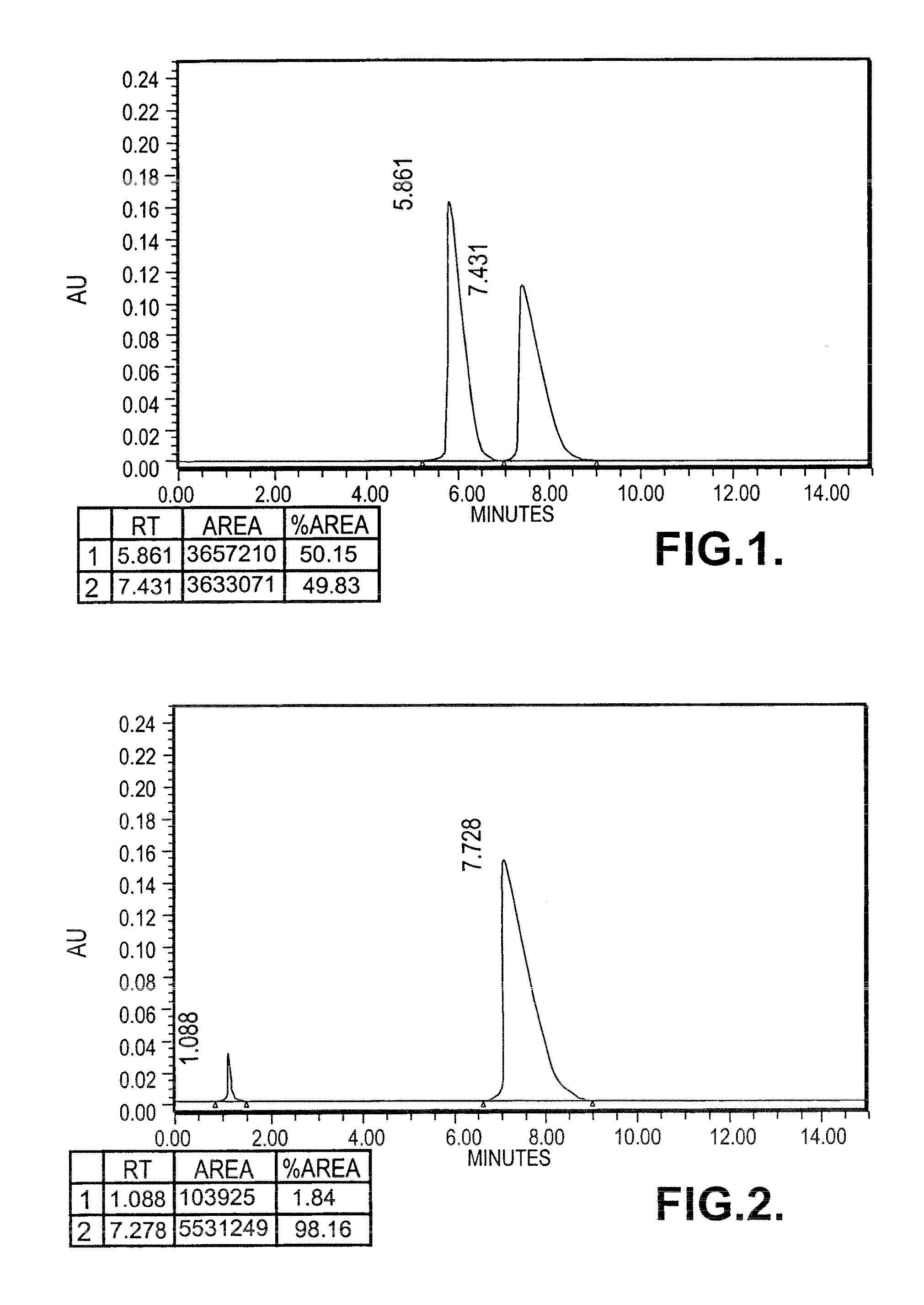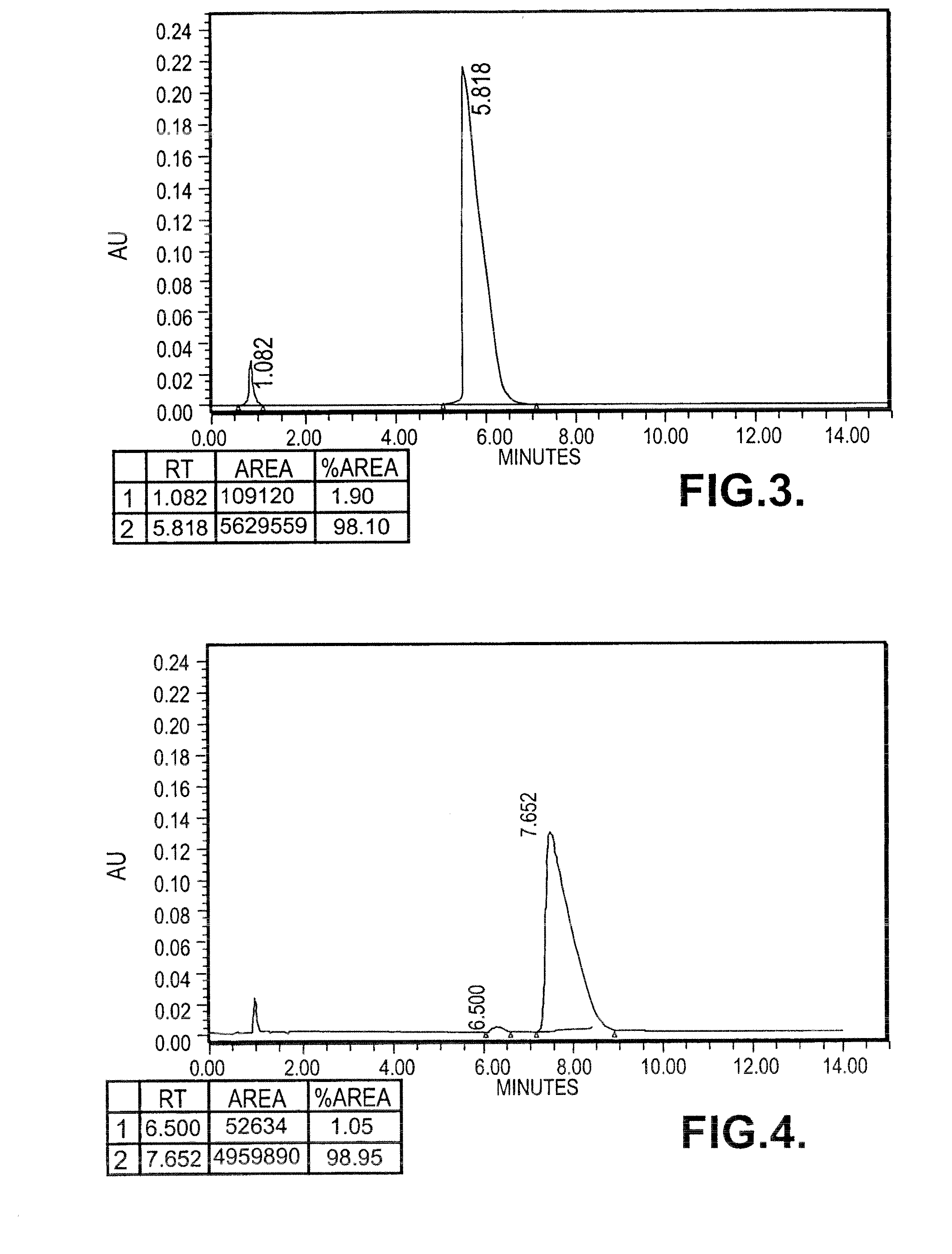Optical enantiomers of phenyramidol and process for chiral synthesis
a technology of phenyramidol and optical enantiomers, which is applied in the field of optical enantiomers of phenyramidol and process for chiral synthesis, can solve the problems of no relevant and/or useful prior art relating to the (r) and (s) isomers of phenyramidol or the process, no satisfactory chiral synthesis or characterization of optical enantiomers of phenyram
- Summary
- Abstract
- Description
- Claims
- Application Information
AI Technical Summary
Benefits of technology
Problems solved by technology
Method used
Image
Examples
example 1
Process for Synthesis of (S)-Phenyramidol
[0121]In a dry reaction flask, 0.18 moles of lithium amide was taken in dimethylformamide (75 ml), added to a solution of 0.165 mole of 2-aminopyridine dissolved in dimethylformamide (30 ml) at 10-30° C. under stirring and the stirring was further continued for 30-60 minutes at the same temperature. The reaction mixture was heated at a temperature of 80° C. and the generated ammonia gas was removed by applying the vacuum. 0.18 moles of (R)-styreneoxide was added drop wise to the reaction mass at a temperature of 90° C. in 1 hr and the reaction mass was maintained at the same temperature for 20-40 mins. The reaction mass was heated up to 110° C. till the completion of reaction and maintained for 20 mins at the same temperature. The solvent dimethylformamide was distilled under reduced pressure. A mixture of Toluene (75 ml) and DM water (150 ml) was added to the reaction mass and stirred at 65° C. for 10-20 min. The organic layer was separated,...
example 2
Process for Synthesis of (S)-Phenyramidol Oxalate Salt
[0125]0.64 moles of (S) Phenyramidol free base (137 gm) was taken in ethyl acetate (400 ml) and heated upto 70° C. Separately oxalic acid dihydrate 80 gm (0.63 mol) was dissolved under heating in ethyl acetate (300 ml) and added to phenyramidol solution. The reaction mass was cooled to room temperature under stirring. The solid separated was filtered and washed with hot ethyl acetate (150 ml) and suck dried under vacuum.
[0126]Specific rotation: [{acute over (α)}]=−59.099° (c=1, methanol)
[0127]Yield: 180 gms (crude salt)
[0128]M.P: 145-154° C.
[0129]To further purify, the oxalate salt (261 gm) was dissolved in methanol (1.75 L) and refluxed with activated charcoal (25 gm) for 0.5-10 h, filtered the hot solution over celite bed and washed with methanol (150 ml). The filtrate was concentrated approximately to 1 L and cooled to room temperature with stirring. The solid separated was filtered under reduced pressure and washed with ethyl...
example 3
Process for Synthesis of (S)-Phenyramidol Hydrochloride Salt
[0137]0.296 moles of (S)-Phenyramidol Oxalate (90 gms) was dissolved in 1.3 litres of de-mineralized water and stirred at 50° C. The pH of the clear solution was between 4 to 5, which was cooled to 20° C. and made alkaline (pH>8) by adding 55 gms of sodium bicarbonate. Precipitated solid was stirred at 28-30° C. for 1 hour, filtered and washed with (500 ml) water and dried under vacuum at 40° C. for 3 hours. Phenyramidol base (61 gms) was dissolved in 180 ml of methanol and refluxed for 1 hour with 6 gms of activated charcoal, filtered, washed with 50 ml of methanol and the filtrate was evaporated to get colourless solid.
[0138]Specific rotation: [{acute over (α)}]=−38.76° (c=1, methanol)
[0139]Yield: 60 gms
[0140]M.P: 105-110° C.
[0141]HPLC Purity: >99%
[0142]Chiral Purity: 99% e.e.
[0143]0.420 moles of (S)-Phenyamidol free base (90 gm) was dissolved in ethanolic hydrochloride (14-16%) under stirring at 28-30° C. The clear solut...
PUM
| Property | Measurement | Unit |
|---|---|---|
| Temperature | aaaaa | aaaaa |
| Temperature | aaaaa | aaaaa |
| Temperature | aaaaa | aaaaa |
Abstract
Description
Claims
Application Information
 Login to View More
Login to View More - R&D
- Intellectual Property
- Life Sciences
- Materials
- Tech Scout
- Unparalleled Data Quality
- Higher Quality Content
- 60% Fewer Hallucinations
Browse by: Latest US Patents, China's latest patents, Technical Efficacy Thesaurus, Application Domain, Technology Topic, Popular Technical Reports.
© 2025 PatSnap. All rights reserved.Legal|Privacy policy|Modern Slavery Act Transparency Statement|Sitemap|About US| Contact US: help@patsnap.com



